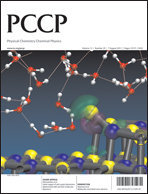Influence of monovalent ion size on colloidal forces probed by Monte Carlo simulations
Abstract
The present work studies the role of ionic size in the interactions between the electrical double layers of colloids immersed into electrolyte solutions of monovalent ions. Such interactions are studied by means of Monte Carlo (MC) simulations and the classical Derjaguin–Landau–Verwey–Overbeek (DLVO) theory. Despite the omission of the steric effects and some other features of real electrolyte solutions, DLVO theory is known to work qualitatively well for 1 : 1 electrolyte solutions. However, this affirmation is based on previous tests where an ionic diameter around 0.4 nm was taken for all ionic species. In contrast, some experimental studies suggest that larger hydrated ions should be considered and even specified for each type of ion. In this work, the importance of ionic size is analyzed by applying the primitive model of electrolyte to the intermediate region between a pair of equally charged infinite planar surfaces. The double layer interactions were calculated from the ionic densities at the distance of closest approach to the charged surfaces, this method constitutes an alternative to the traditional calculations at the midplane. Our MC simulations predict the existence of negative net pressures for monovalent electrolytes in the case of zero charge density. In addition, MC simulations reveal some disagreements with theoretical predictions for ionic diameters larger than 0.4 nm. These discrepancies can become significant if surface charge density is large enough due to the restructuration of the double layer. The physical mechanisms for these deviations are also discussed.


 Please wait while we load your content...
Please wait while we load your content...